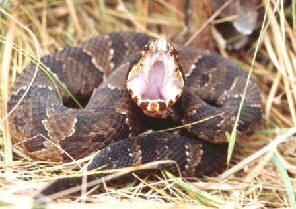Cottonmouth Snake
|
Cottonmouth Snakes reside mainly in the south eastern United States. Subspecies are accounted for in Central America, Asia, south eastern Europe, and Malaysia. They are large, aquatic, venomous snakes. They are rarely found far from a permanent water source, such as a slow moving stream, edge of a lake, pond, swamp, or even brackish tidal estuaries. Cottonmouth Snakes swim with much of their bodies floating above the surface distinguishing them from water snakes, which tend to swim mostly below the surface, sometimes with their heads protruding. Throughout much of their range, they are found in open flat wood pine forests or bald cypress swamps. The name cottonmouth comes from the fact that its mouth looks like cotton when it is open. Cottonmouth Snakes can be aggressive. They will often stand their ground. Cottonmouth Snakes venom is stronger and they tend to be larger snakes, making them very dangerous. When startled they will often stand its ground and open it's mouth ('gape' or 'smile') to warn predators to stay away. This behaviour is seen many times as aggressive, however, if left alone they will just slip away.
Cottonmouth Snakes take a wide variety of prey including fish, small mammals, lizards, birds, small turtles, baby alligators and even other snakes. Usually a victim is envenomed quickly with a bite and then released. If the prey does not succumb immediately, it is tracked by scent. Like all pit vipers, the Cottonmouth Snake has pits on the sides of its nose that sense body heat of warm blooded animals in the form of infrared light, therefore, its hunting ability is not impaired at night. The name 'cottonmouth' is earned by the snake's tendency to open its mouth widely, displaying white tissue inside as a warning gesture.
Cottonmouth Snakes commonly exceed 80 centimetres in length, with males growing larger than females. Occasionally, individuals may exceed 180 centimetres in length. They have a heavy body with a moderately long tail. Cottonmouth Snakes are generally dark coloured with tones of olive, brown or black. A lighter/darker cross banding pattern may be seen, especially on their sides. The dorsal banding pattern fades with age, so that older individuals are an almost uniform olive brown, greyish brown or black. Their belly is white, yellowish white or tan, marked with dark spots and becomes darker near the posterior. The amount of dark pigment on the belly varies from virtually nothing to almost completely black. Their head is more or less uniform brown colour. The underside of the head is generally whitish, cream or tan. Juvenile Cottonmouth snakes generally have a more contrasting colour pattern, with dark cross bands on a lighter ground colour. The ground colour is either tan, brown or reddish brown. The tip of the tail is usually yellowish, becoming greenish yellow or greenish in sub adults and then black in adults. On some juveniles, the banding pattern can also be seen on the tail.
The venom of the Cottonmouth Snake is hemotoxic (toxins that destroy red blood cells), causing swelling and necrosis (accidental death of cells and living tissue) near the site of the wound and potentially death of the victim if treatment is not received promptly. They are capable of inflicting what is referred to as a 'dry bite', where no venom is injected, however, any bite from a venomous snake should be treated as serious and immediate medical attention sought, even if no immediate effects from the venom are felt. The bite is extremely painful, prone to gangrene and loss of digits without adequate treatment.
|

